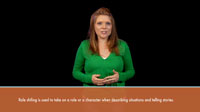Learn & Master Sign Language covers everything from fingerspelling to introductions to where you live to the many different activities you may enjoy. And within each lesson, we will discuss different features of American Sign Language, including expansion techniques, grammar, and interesting facts and stories about deaf culture.

Every language starts with a foundation of the alphabet and basic words and principles. In beginning lessons of the course, we'll teach you the alphabet, colors, common words, and basic sentences that allow you to begin communication with deaf community. We'll also show you how to use your dominant hand and gesturing to help convey your message as you're learning the language.

Like any language, American sign language contains its own grammatical rules. Those rules, however, are very different from English. In these lessons, we'll teach you how to use proper ASL grammar, which include proper facial expressions and body movements.

Because you lead a full and active life, we'll teach you the signs needed to communicate while doing everyday activities. Activities such as sporting events, hobbies, managing your calendar and time, traveling, and eating out at restaurants are just the start.

A unique component of American Sign Language is the use of expansion techniques to clearly communicate your message. You'll learn eight techniques in Learn and Master Sign Language, from reiteration to scaffolding to faceting and several more.

Not only will you learn ASL as a language, you are also going to learn about the dynamic culture of Deaf People. Many people don't realize it, but Deaf people have a very strong and connected culture. As you learn more about Deaf People and Deaf Culture, you will feel a deep sense of camaraderie among a very rich community.

An important piece of sign language is learning and improving your expressive and receptive fingerspelling skills. From the beginning of the course through the end, you'll have opportunities to practice your fingerspelling with quizzes and activities. You'll even be able to start at a slow, beginner speed and progress to a fast, advanced speed by the end of the course.

Sometimes in American Sign Language there is not a specific sign to communicate an idea. That's when you incorporate handshapes, called classifiers, into your language skills. You'll learn numerous handshapes and how each could be used to communicate ideas and concepts.